Richard Rae has known Dave Lowe for a long time. Richard came down to visit Dave in Oxford on Saturday and, fortunately, said that he would like to try to see the Common Cranes on Otmoor. They duly came across a pair of Common Cranes on the reserve and then began to scan the area known as Big Otmoor for other birds.
That was when Richard exclaimed, “Am I going mad?“. Dave, immediately responded “Yes“. Dave has known Richard for a long time, he could confidently answer, without knowing any of the context of Richard’s rhetorical question. Richard followed up with “Is that a Stilt?“, whereupon Dave began taking Richard’s questions much more seriously. For there was indeed, a fabulous Black-winged Stilt, feeding on one of the pools close to the main bridleway:

The rain on Saturday afternoon seems to have brought this migrating bird down to feed in the wet pools and marshes of Otmoor, but it was keen to keep moving. After a short period of time, Dave and Richard watched the Black-winged Stilt depart, flying up into the cloud base, heading north. Perhaps the low cloud deterred it from continuing its journey, for fifteen minutes later it was back, on the same pool. Even better, I was just about to arrive on Otmoor. The Stilt then moved to feed further away, where the video below begins, before returning once again to its favourite pool, the final few scenes on the video, which are taken through quite a lot of reeds:

Stilts are not only unmistakable and beautiful birds, but are also very rare birds in Oxfordshire. Ian Lewington, the county recorder, passed on the fact that this was the fifth Oxfordshire record (and the eighth bird) after one at Shipton Quarry in June 1993; three at Radley in June 1993; one at Pit 60 in April 2012 and two there in May 2017. So, all in all, a quality find from team Lowe-Rae. Unfortunately, the Black-winged Stilt departed overnight and was not seen the following morning. This bird continues a remarkable run of rare birds on Otmoor this spring, following the long-staying Spotted Crake and the very brief Night Heron. A long-staying Purple Heron would be much appreciated next. It would help bury the trauma of the Blenheim Purple Heron.
